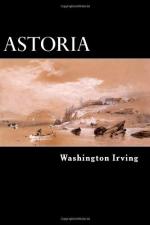The boats proceeded for the greater part of the day without seeing any signs of an enemy. About four o’clock in the afternoon the large boat, commanded by Mr. Hunt, came to where the river was divided by a long sand-bar, which apparently, however, left a sufficient channel between it and the shore along which they were advancing. He kept up this channel, therefore, for some distance, until the water proved too shallow for the boat. It was necessary, therefore, to put about, return down the channel, and pull round the lower end of the sand-bar into the main stream. Just as he had given orders to this effect to his men, two signal guns were fired from the boats on the opposite side of the river. At the same moment, a file of savage warriors was observed pouring down from the impending bank, and gathering on the shore at the lower end of the bar. They were evidently a war party, being armed with bows and arrows, battle clubs and carbines, and round bucklers of buffalo hide, and their naked bodies were painted with black and white stripes. The natural inference was, that they belonged to the two tribes of Sioux which had been expected by the great war party, and that they had been incited to hostility by the two chiefs who had been enraged by the refusal and the menace of Mr. Hunt. Here then was a fearful predicament. Mr. Hunt and his crew seemed caught, as it were, in a trap. The Indians, to a number of about a hundred, had already taken possession of a point near which the boat would have to pass: others kept pouring down the bank, and it was probable that some would remain posted on the top of the height.
The hazardous situation of Mr. Hunt was perceived by those in the other boats, and they hastened to his assistance. They were at some distance above the sand-bar, however, and on the opposite side of the river, and saw, with intense anxiety, the number of savages continually augmenting, at the lower end of the channel, so that the boat would be exposed to a fearful attack before they could render it any assistance. Their anxiety increased, as they saw Mr. Hunt and his party descending the channel and dauntlessly approaching the point of danger; but it suddenly changed into surprise on beholding the boat pass close by the savage horde unmolested, and steer out safely into the broad river.
The next moment the whole band of warriors was in motion. They ran along the bank until they were opposite to the boats, then throwing by their weapons and buffalo robes, plunged into the river, waded and swam off to the boats and surrounded them in crowds, seeking to shake hands with every individual on board; for the Indians have long since found this to be the white man’s token of amity, and they carried it to an extreme.




